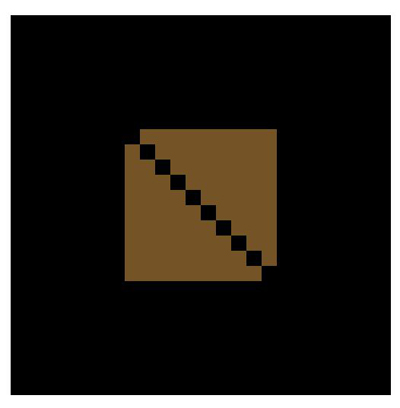 interface Web
interface Web
 js tutoriel
js tutoriel
 Comment supprimer une zone de bloc en JavaScript html5 Canvas_Javascript Skills
Comment supprimer une zone de bloc en JavaScript html5 Canvas_Javascript Skills
Comment supprimer une zone de bloc en JavaScript html5 Canvas_Javascript Skills
L'exemple de cet article décrit comment supprimer une zone de bloc dans le canevas html5. Partagez-le avec tout le monde pour votre référence, les détails sont les suivants :
La capture d'écran de l'effet en cours d'exécution est la suivante :

Pièce jointe : Sur la photo, le petit carré noir est la zone de bloc supprimée
Le code spécifique est le suivant :
index.html:
<!DOCTYPE html>
<html>
<head>
<meta http-equiv="Content-type" content="text/html;charset=UTF-8" />
<title>canvas中删除一块区域</title>
<style type="text/css">
#canvas {
background:black; margin-top:100px; margin-left:200px;
}
</style>
</head>
<body>
<canvas id="canvas" width="500px" height="500px" ></canvas>
</body>
<script type="text/javascript" src="canvas.js"></script>
<script type="text/javascript">
cache = {};
var offsetX = 50,
offsetY = 20;
cache.context = dyl.createContext('canvas');
dyl.rect(dyl.createColor(), 150, 150, 200, 200, 0.5);
for(var i=0; i<10; i++) {
dyl.clearRect(150 + i*20, 150 + i*20, 20, 20);
}
</script>
</html>
canvas.js :
(function() {
var dyl = {cache: {}};
dyl.setContext = function(context) {
dyl.cache._context = context;
return context;
};
dyl.getDom = function(id) {
return document.getElementById(id);
};
dyl._getContext = function() {
return dyl.cache._context;
};
dyl.save = function() {
var context = dyl._getContext();
context ? context.save() : void(0);
};
dyl.restore = function() {
var context = dyl._getContext();
context ? context.restore() : void(0);
};
dyl.createContext = function(canvasID) {
var canvas = this.getDom(canvasID);
if(!canvas) {
return null;
}
return dyl.setContext(canvas.getContext("2d"));
};
dyl.createColor = function() {
var color = "rgb(";
color += Math.round(Math.random()*255);
color += ",";
color += Math.round(Math.random()*255);
color += ",";
color += Math.round(Math.random()*255);
color += ")";
return color;
};
dyl.addImg = function(img, x, y) {
var context = dyl._getContext();
if(!img || !context) {
return;
}
if(typeof img === "string") {
var oImg = new Image();
oImg.src = img;
oImg.onload = function() {
context.drawImage(oImg, x, y);
}
return;
}
context.drawImage(img, x, y);
};
dyl.rect = function(color, x, y, width, height, alpha) {
var context = dyl._getContext();
if(!context) {
return;
}
context.save();
context.fillStyle = color;
context.globalAlpha = alpha ? alpha : 1;
context.fillRect(x, y, width, height);
context.restore();
};
dyl.circle = function(color, x, y, r, alpha) {
var context = dyl._getContext();
context.save();
context.fillStyle = color;
context.beginPath();
context.globalAlpha = alpha ? alpha : 1;
context.arc(x, y, r, 0, 2*Math.PI);
context.fill();
context.stroke();
};
dyl.clearRect = function(x, y, width, height) {
var context = dyl._getContext();
if(!context) {
return;
}
context.clearRect(x, y, width, height);
};
dyl.scale = function(x, y) {
var context = dyl._getContext();
if(!context) {
return;
}
x = x ? x : 1;
y = y ? y : 1;
context.scale(x, y);
};
if(!window.dyl) {
window.dyl = dyl;
}
})();
J'espère que cet article sera utile à tout le monde dans la programmation JavaScript.

Outils d'IA chauds

Undresser.AI Undress
Application basée sur l'IA pour créer des photos de nu réalistes

AI Clothes Remover
Outil d'IA en ligne pour supprimer les vêtements des photos.

Undress AI Tool
Images de déshabillage gratuites

Clothoff.io
Dissolvant de vêtements AI

AI Hentai Generator
Générez AI Hentai gratuitement.

Article chaud

Outils chauds

Bloc-notes++7.3.1
Éditeur de code facile à utiliser et gratuit

SublimeText3 version chinoise
Version chinoise, très simple à utiliser

Envoyer Studio 13.0.1
Puissant environnement de développement intégré PHP

Dreamweaver CS6
Outils de développement Web visuel

SublimeText3 version Mac
Logiciel d'édition de code au niveau de Dieu (SublimeText3)
 Bordure de tableau en HTML
Sep 04, 2024 pm 04:49 PM
Bordure de tableau en HTML
Sep 04, 2024 pm 04:49 PM
Guide de la bordure de tableau en HTML. Nous discutons ici de plusieurs façons de définir une bordure de tableau avec des exemples de bordure de tableau en HTML.
 Marge gauche HTML
Sep 04, 2024 pm 04:48 PM
Marge gauche HTML
Sep 04, 2024 pm 04:48 PM
Guide de la marge HTML gauche. Nous discutons ici d'un bref aperçu de la marge gauche HTML et de ses exemples ainsi que de son implémentation de code.
 Tableau imbriqué en HTML
Sep 04, 2024 pm 04:49 PM
Tableau imbriqué en HTML
Sep 04, 2024 pm 04:49 PM
Ceci est un guide des tableaux imbriqués en HTML. Nous discutons ici de la façon de créer un tableau dans le tableau ainsi que des exemples respectifs.
 Disposition du tableau HTML
Sep 04, 2024 pm 04:54 PM
Disposition du tableau HTML
Sep 04, 2024 pm 04:54 PM
Guide de mise en page des tableaux HTML. Nous discutons ici des valeurs de la mise en page des tableaux HTML ainsi que des exemples et des résultats en détail.
 Liste ordonnée HTML
Sep 04, 2024 pm 04:43 PM
Liste ordonnée HTML
Sep 04, 2024 pm 04:43 PM
Guide de la liste ordonnée HTML. Ici, nous discutons également de l'introduction de la liste et des types HTML ordonnés ainsi que de leur exemple respectivement.
 Espace réservé d'entrée HTML
Sep 04, 2024 pm 04:54 PM
Espace réservé d'entrée HTML
Sep 04, 2024 pm 04:54 PM
Guide de l'espace réservé de saisie HTML. Nous discutons ici des exemples d'espace réservé d'entrée HTML ainsi que des codes et des sorties.
 Déplacer du texte en HTML
Sep 04, 2024 pm 04:45 PM
Déplacer du texte en HTML
Sep 04, 2024 pm 04:45 PM
Guide pour déplacer du texte en HTML. Nous discutons ici d'une introduction, du fonctionnement des balises de sélection avec la syntaxe et des exemples à implémenter.
 Bouton HTML onclick
Sep 04, 2024 pm 04:49 PM
Bouton HTML onclick
Sep 04, 2024 pm 04:49 PM
Guide du bouton HTML onclick. Nous discutons ici de leur introduction, de leur fonctionnement, des exemples et de l'événement onclick dans divers événements respectivement.





